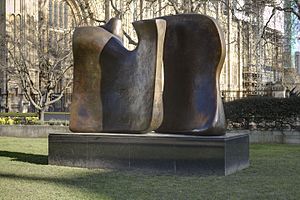Knife Edge Two Piece
| Knife Edge Two Piece 1962–65 | |
|---|---|

The cast in Westminster, London, in 2015
|
|
| Artist | Henry Moore |
| Year | 1962–1965 |
| Type | Bronze |
| Dimensions | 366 cm (144 in) |
|
51°29′52.64″N 0°7′33.75″W / 51.4979556°N 0.1260417°W (London cast) 49°14′29.37″N 123°6′49.13″W / 49.2414917°N 123.1136472°W (Vancouver cast) 41°5′24.85″N 73°50′37.87″W / 41.0902361°N 73.8438528°W (Kykuit cast) 51°50′10.16″N 0°5′7.24″E / 51.8361556°N 0.0853444°E (Perry Green cast) |
|
Knife Edge Two Piece 1962–65 is an abstract bronze sculpture by Henry Moore. It is one of Moore's earliest sculptures in two pieces, a mode that he started to adopt in 1959. Its form was inspired by the shape of a bone fragment. Moore created the sculpture from an edition of 10 working models in 1962; these working models are now in public collections. Moore created four full-size casts between 1962-1965, with one retained by him. The three casts are on public display on College Green in Westminster, London, Queen Elizabeth Park in Vancouver, and the garden at Kykuit, the house of the Rockefeller family in Tarrytown, New York. Moore's own cast is on display at his former studio and estate, 'Hoglands' in Perry Green, Hertfordshire in southern England. A similar work, Mirror Knife Edge 1977 (or Knife Edge Mirror Two Piece), is displayed at the entrance to I. M. Pei's east wing of the National Gallery of Art in Washington, D.C. The Westminster cast was donated by Moore through the Contemporary Art Society to what he believed was the City of London, but its actual ownership was undetermined for many years. The Westminster cast subsequently fell into disrepair, and was restored in 2013 after it became part of the British Parliamentary Art Collection; it was granted a Grade II* listing in January 2016.
By 1960 Moore was moving on from his earlier works, directly inspired by the human form and with textured surfaces, such as Draped Seated Woman 1957–58, to more rounded abstract shapes, inspired by the shapes of stones or bones. Moore made a connected work in 1961, also inspired by bone, Standing Figure (Knife Edge) (LH 482).
In 1962 Moore created an edition of 10 working models (LH 504) for a new two-piece sculpture. The Tate Gallery in London acquired a small working model in 1963. Other working models are in the collections of the Gemeentemuseum in The Hague, the Didrichsen Art Museum in Helsinki, the Memorial Art Gallery of the University of Rochester in Rochester, New York, and the Kunsthaus in Zurich. Moore planned the full-size sculpture to be over 10 feet high, large enough for a person to walk between the two elements.
...
Wikipedia
